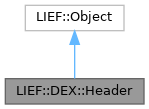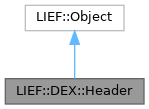Class which represents the DEX header. This is the first structure that begins the DEX format. More...
#include <Header.hpp>


Public Types | |
| using | location_t = std::pair<uint32_t, uint32_t> |
| using | magic_t = std::array<uint8_t, 8> |
| using | signature_t = std::array<uint8_t, 20> |
| Public Types inherited from LIEF::Object | |
| template<class T> | |
| using | output_t = add_pointer_t<decay_t<T>> |
| template<class T> | |
| using | output_const_t = add_pointer_t<add_const_t<decay_t<T>>> |
Public Member Functions | |
| Header () | |
| Header (const Header &) | |
| Header & | operator= (const Header &) |
| template<class T> | |
| Header (const T &header) | |
| magic_t | magic () const |
| The DEX magic bytes (DEX\n followed by the DEX version). | |
| uint32_t | checksum () const |
| The file checksum. | |
| signature_t | signature () const |
| SHA-1 DEX signature (which is not really used as a signature). | |
| uint32_t | file_size () const |
| Size of the entire file (including the current the header). | |
| uint32_t | header_size () const |
| Size of this header. It should be 0x70. | |
| uint32_t | endian_tag () const |
| File endianess of the file. | |
| uint32_t | map () const |
| Offset from the start of the file to the map list (see: DEX::MapList). | |
| location_t | strings () const |
| Offset and size of the string pool. | |
| location_t | link () const |
| location_t | types () const |
| location_t | prototypes () const |
| location_t | fields () const |
| location_t | methods () const |
| location_t | classes () const |
| location_t | data () const |
| uint32_t | nb_classes () const |
| uint32_t | nb_methods () const |
| void | accept (Visitor &visitor) const override |
| ~Header () override | |
| Public Member Functions inherited from LIEF::Object | |
| Object () | |
| Object (const Object &other) | |
| Object & | operator= (const Object &other) |
| Object (Object &&other) noexcept=default | |
| Object & | operator= (Object &&other) noexcept=default |
| template<class T> | |
| output_t< T > | as () |
| template<class T> | |
| output_const_t< T > | as () const |
| virtual bool | operator== (const Object &other) const |
| virtual bool | operator!= (const Object &other) const |
| virtual | ~Object () |
Detailed Description
Class which represents the DEX header. This is the first structure that begins the DEX format.
The official documentation is provided here: https://source.android.com/devices/tech/dalvik/dex-format#header-item
Member Typedef Documentation
◆ location_t
| using LIEF::DEX::Header::location_t = std::pair<uint32_t, uint32_t> |
◆ magic_t
| using LIEF::DEX::Header::magic_t = std::array<uint8_t, 8> |
◆ signature_t
| using LIEF::DEX::Header::signature_t = std::array<uint8_t, 20> |
Constructor & Destructor Documentation
◆ Header() [1/3]
| LIEF::DEX::Header::Header | ( | ) |
Referenced by Header(), operator<<, and operator=().
◆ Header() [2/3]
◆ Header() [3/3]
| LIEF::DEX::Header::Header | ( | const T & | header | ) |
References LIEF_LOCAL.
◆ ~Header()
|
override |
Member Function Documentation
◆ accept()
|
overridevirtual |
Implements LIEF::Object.
◆ checksum()
| uint32_t LIEF::DEX::Header::checksum | ( | ) | const |
The file checksum.
◆ classes()
| location_t LIEF::DEX::Header::classes | ( | ) | const |
◆ data()
| location_t LIEF::DEX::Header::data | ( | ) | const |
◆ endian_tag()
| uint32_t LIEF::DEX::Header::endian_tag | ( | ) | const |
File endianess of the file.
◆ fields()
| location_t LIEF::DEX::Header::fields | ( | ) | const |
◆ file_size()
| uint32_t LIEF::DEX::Header::file_size | ( | ) | const |
Size of the entire file (including the current the header).
◆ header_size()
| uint32_t LIEF::DEX::Header::header_size | ( | ) | const |
Size of this header. It should be 0x70.
◆ link()
| location_t LIEF::DEX::Header::link | ( | ) | const |
◆ magic()
◆ map()
| uint32_t LIEF::DEX::Header::map | ( | ) | const |
Offset from the start of the file to the map list (see: DEX::MapList).
◆ methods()
| location_t LIEF::DEX::Header::methods | ( | ) | const |
◆ nb_classes()
| uint32_t LIEF::DEX::Header::nb_classes | ( | ) | const |
◆ nb_methods()
| uint32_t LIEF::DEX::Header::nb_methods | ( | ) | const |
◆ operator=()
◆ prototypes()
| location_t LIEF::DEX::Header::prototypes | ( | ) | const |
◆ signature()
| signature_t LIEF::DEX::Header::signature | ( | ) | const |
SHA-1 DEX signature (which is not really used as a signature).
◆ strings()
| location_t LIEF::DEX::Header::strings | ( | ) | const |
Offset and size of the string pool.
◆ types()
| location_t LIEF::DEX::Header::types | ( | ) | const |
The documentation for this class was generated from the following file:
Generated by